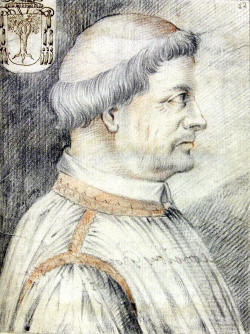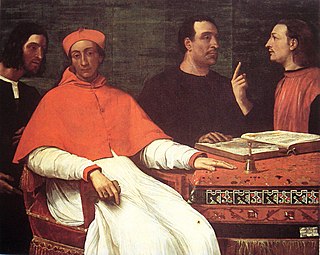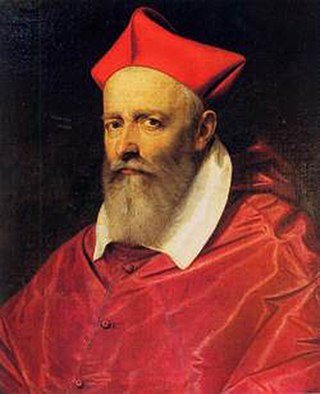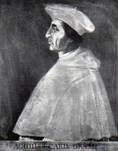
Pope Julius II was head of the Catholic Church and ruler of the Papal States from 1503 to his death, in February 1513. Nicknamed the Warrior Pope, the Battle Pope or the Fearsome Pope, it is often speculated that he had chosen his papal name not in honor of Pope Julius I but in emulation of Julius Caesar. One of the most powerful and influential popes, Julius II was a central figure of the High Renaissance and left a significant cultural and political legacy. As a result of his policies during the Italian Wars, the Papal States increased their power and centralization, and the office of the papacy continued to be crucial, diplomatically and politically, during the entirety of the 16th century in Italy and Europe.

Guido Bentivoglio d'Aragona was an Italian cardinal, statesman and historian.

Pietro Accolti, known as the "cardinal of Ancona", was an Italian Roman Catholic cardinal and judge of the Roman Rota.
Paris de Grassis was the master of ceremonies to Pope Julius II and Pope Leo X. He joined the Office of Ceremonies in May 1504 as a participating ceremonialist, progressed to role of president of the Office when he became bishop of Pesaro in 1513, and continued as president until he died in 1528. De Grassis' diary covers his work at the papal court from 1504 to 1521.

François Guillaume de Castelnau de Clermont-Lodève (1480–1541) was a French diplomat and Cardinal. He was the son of Pierre-Tristan, Seigneur de Clermont et de Clermont-Lodève and Vicomte de Nébouzan, and Catherine d'Amboise. His father was a member of the Order of Saint Michael. François' grandmother had been heiress of Dieudonné Guillaume de Clermont. He had an elder brother, Pierre de Castelnau, who was heir to the family estates. François was also the nephew of Cardinal Georges d'Amboise (1498-1510), who was largely responsible for François' swift rise to prominence in the Church. Cardinal d'Amboise had been Archbishop of Narbonne from 1491 to 1494.

The 1534 papal conclave was convened after the death of Pope Clement VII, and elected as his successor Cardinal Alessandro Farnese, who became Pope Paul III.

Innocenzo Cibo was an Italian cardinal and archbishop.

Marco Cornaro, also known as Cardinal Cornaro and Cardinal Cornelius, was an Italian Roman Catholic cardinal and bishop.

Francisco de Remolins was a Spanish Roman Catholic bishop and cardinal.

Marco Vigerio della Rovere was an Italian bishop and cardinal of the Catholic Church.

Leonardo Grosso della Rovere was an Italian Roman Catholic bishop and cardinal.

Antonio Maria Ciocchi del Monte was an Italian Roman Catholic bishop and cardinal.

Bandinello Sauli was an Italian Roman Catholic bishop and cardinal.
Bonifacio Ferrero (1476–1543) was an Italian Roman Catholic bishop and cardinal.
Domenico Giacobazzi (1444–1528) was an Italian Roman Catholic bishop and cardinal.
Ferdinando Ponzetti (1444–1527) was an Italian Roman Catholic bishop and cardinal.
Esteban Gabriel Merino was a Spanish Roman Catholic bishop and cardinal.

Giacomo Savelli (1523–1587) was an Italian Roman Catholic cardinal and bishop. He participated in several papal conclaves and held several administrative positions in the Catholic Church during his 48 year career with the Church during the mid 16th century.
Girolamo Recanati Capodiferro was an Italian Roman Catholic bishop and cardinal.
Scipione Lancelotti (1527–1598) was an Italian who became a cardinal within the Roman Catholic Church.












